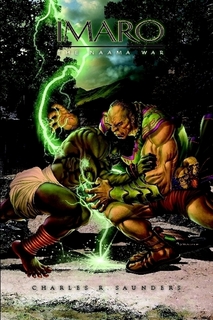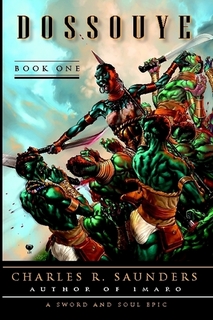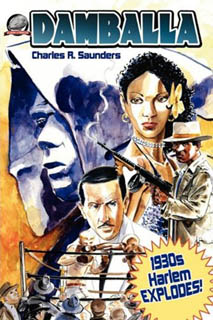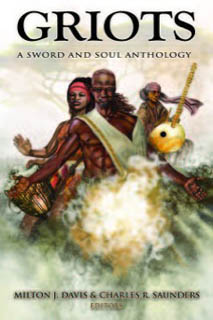Charles R. Saunders began his career writing stories and essays for fanzines in the early 1970s. In 1981 he published the novel IMARO to great critical acclaim; set in an alternate-earth Africa it was the first sword and sorcery novel that featured a black hero and was well-rooted in African history, mythology, and folklore rather than the prevalent Celtic, Arthurian, and Scandinavian inspired fantasies. Two more Imaro novels followed before he left fantasy writing to try his hand at writing screenplays, radio plays, political columns, editorials, and books on African-Canadian history. In the last several years Charles has made a comeback in the fantasy world and his novel DAMBALLA is taking the "new pulp" world by storm.

When did you first discover Philip José Farmer, do you recall the first novel or story of his you read?
I've read so many of his books, I can't remember what the first one was. But the first one that made a big impression on me was THE MAKER OF UNIVERSES. The sheer outpouring of imagination in that novel, and the rest of the World of Tiers series, was astounding to my youthful mind. A planet shaped like a wedding cake, populated by a mash-up of historical and mythological peoples, with super-advanced technology to boot. . . It was like walking through a fantastical funhouse.
Do you have a favorite Farmer novel?
The whole Riverworld series. Phil Farmer is the only writer with the imagination to come up with such a notion of the afterlife, and the only one talented to have pulled off such a grand concept.
What sort of influence did Farmer have on you?
He was not a direct influence, like Robert E. Howard or H.P. Lovecraft. Farmer's influence was more indirect, as in reminding me that in SF and fantasy, the possibilities are infinite.
You are best known for your stories and novels about Imaro, the Nyumbani (a magical version of Africa) warrior who could go toe to toe with Conan or Tarzan. When you first had the idea to write sword and sorcery stories based on African legends and folklore, did you then do the research, or were you already familiar with African mythology?
In the mid- and late-1960s, I made two life-changing discoveries. The first was the full panoply of African history, culture, mythology and folklore. The other was sword-and-sorcery. My interest in Africa came first; sword-and-sorcery came hard on its heels. The eventual commingling of those two passions was inevitable. Of course, I continued to do research specific to the stories I was writing. But the general interest in matters African was there well beforehand.

The same way Phil suffered major setbacks early in his writing career, you've also hit some pretty big stumbling blocks along the way. In 2008 you launched Sword and Soul Media to bring your old books back into print as well as for publishing new material. Has this been successful for you?
Actually, Sword & Soul Media was launched by my friend Brother Uraeus. A bit before Night Shade Books dropped the Imaro series after the second volume, Uraeus approached me about publishing a collection of my stories about Dossouye, the African Amazon, via print-on-demand. The idea sounded good to me. It sounded even better after Imaro's horse was shot out from under him. Uraeus and I decided that Sword & Soul Media would also publish IMARO III and IV. As of now, Sword & Soul Media has published DOSSOUYE, IMARO: The Trail of Bohu (Imaro III) and IMARO: The Naama War (Imaro IV). Waiting in the wings is DOSSOUYE II. Then comes IMARO V.
In addition to launching a new series about the female warrior Dossouye and writing the fifth Imaro novel, you've also talked about publishing a collection of short stories set in Nyumbani. Some of these are about Imaro, but most are not. Will this collection see print anytime soon?
Well, we're talking two collections, not just one. The first collection will consist of ten Imaro short stories. Seven of those stories have previously been published in magazines and anthologies over the years. Three of them are brand-new, written especially for the collection. The other collection will consist of African-inspired stories that do not feature either Imaro or Dossouye. It will be a while before those collections see print, but they are definitely in the Sword & Soul Media pipeline.
You've also written a lot of genre nonfiction articles that appeared in fanzines in the 1970s and 1980s (including "Farmer of the Apes" which originally appeared in Borealis Vol. 1 #2, Spring 1978 and was later reprinted in Farmerphile #13, July 2008). Do you have any plans to publish a collection of your nonfiction?
Ever since I started my website (www.charlessaunderswriter.com) three years ago, I've been posting reprints of my old articles. So that kind of precludes any notion of publishing them in book form. I don't regret posting them, though. I enjoy seeing what people think of them decades after they first came out in those zines.

In a 2006 interview you said you've begun writing a "multi-volume epic African-oriented fantasy saga called Abengoni, which is Tolkienian in scope if not subject matter." What can you tell us about this project? Have you made much progress on it since 2006, and when it might see publication?
I started working on Abengoni during the period between the retirement and revival of Imaro. The series is about an encounter between African and European cultures, minus the racial baggage that we're still carrying to this day. I stopped working on it when I brought Imaro back. Now that I've written the five Imaro novels I wanted to write, I've gone back to Abengoni. The first novel is completed; the second nearly so. There will definitely be a third volume, and possibly a fourth. I don't want to say much more about it until I've got it done.
Your latest novel, DAMBALLA about a black pulp-type hero from the 1930s, is a completely new direction for you. When Phil decided to write about pulp characters, he was in a way returning to his literary roots (although he read everything as a child, not just the pulps). Was this the case for you, did you grow up reading the pulps, and if not, when did you discover them?
I wasn't born soon enough to have read the pulps in their heyday, as Phil did. Pulps were on their last legs when I was a child, and by the time I became old enough to read them, they were gone. They were replaced in part by paperback books, which I read avidly. It was through reading the paperbacks that I learned about their progenitors, the pulps.
DAMBALLA has a very interesting backstory. First, you used real events as part of his origin story, and while the reader may be expecting a character with superior physical skills and knowledge of "mysterious" African herbs, potions, and even voodoo, his knowledge of chemistry, physics, biology, etc., learned at various European universities, came as a nice surprise. Can we expect more surprises like this from him in the future?
A second Damballa novel is on my agenda, and it will definitely contain some surprises. I'll probably surprise myself as I go along.

There is a lot of "new pulp" coming out these days, any chance we might see Damballa short stories appearing in magazine or anthologies, or do you think you'll stick to novels?
I won't say "never," but at this point, my Damballa story-ideas need the length of a novel to be told properly.
As if writing a second DOSSOUYE novel, a fifth IMARO novel, and the debut DAMBALLA novel wasn't enough to keep you busy, you also just co-edited an anthology titled GRIOTS: A Sword and Soul Anthology. What can you tell us about this project?
"Sword and Soul" is a term I coined for fantasy and sword-and-sorcery written from an African-inspired perspective. Milton Davis, author of the novels MEJI I and MEJI II, along with CHANGA'S SAFARI, suggested that enough writers had become interested in this type of work to make an anthology of their stories not only feasible, but also desirable. We put out a call for stories, and the result was gratifying. Milton has a new Changa story in GRIOTS, and I contributed a new Imaro story. The book boasts fourteen stories in all, by both established and up-and-coming authors, illustrated by fourteen different artists. A second volume, GRIOTS II: Sisters of the Spear, is in the works.
While it doesn't seem possible, is there anything else on the horizon, any projects we've haven't already discussed?
Right now, my plate overfloweth. If there's anything else waiting on the horizon, it's in hiding, waiting to ambush me.